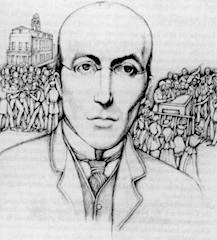|
J. William T. "Bill" Youngs, American Realities, Volume One:
Historical Episodes from First Settlements to the Civil War, Chapter Ten |
"William Lloyd Garrison" courtesy of the Library of Congress
|
10. Abolitionists and Antiabolitionists
|
Summary |
|
During the nineteenth century, the greatest blemish on America’s character as a free society was slavery, which grew ever more entrenched as cotton production expanded. Many Americans favored slavery, but abolition became a major reform impulse by 1835. In the Boston anti-abolitionist riot of that year, we can see two facets of antislavery history: the ideals of a leading abolitionist and the persistent support for slavery, even in the North.
|
Author Reads From the Text
On a train from Boston to New York, William Lloyd Garrison sat near two ladies, “one a fat dowager-looking female—the other younger and less corpulent—probably mother and daughter.” In Canton a gentleman jokingly expressed his surprise that these ladies should be on the train rather than attending a local ladies antislavery meeting, then in progress.
“Oh,” they said quite emphatically, “we are not antislavery.”
They spoke as if they were testifying to something more than their view on the great social question of the day. They were testifying to their own character, indicating that they were stable, sensible, and respectable—as if no one of any consequence could possibly be an abolitionist.
The loud rattling of the cars and Garrison’s sense of propriety kept him from joining the conversation, but he wanted to say to them: “What! Not antislavery? Do you mean to say that you are in favor of slavery? Or what do you mean? If you are not antislavery, then you are for concubinage, pollution, robbery, cruelty; then you are for making merchandise of God’s image, for setting aside the forms and obligations of marriage, for darkening the human intellect, and debasing the soul.” He was pleased that a few miles away in Canton, Massachusetts, there were other women, “high-souled, intellectual, courageous, devout females,” who were at that moment meeting to express their hostility to slavery.
“Oh,” they said quite emphatically, “we are not antislavery.”
They spoke as if they were testifying to something more than their view on the great social question of the day. They were testifying to their own character, indicating that they were stable, sensible, and respectable—as if no one of any consequence could possibly be an abolitionist.
The loud rattling of the cars and Garrison’s sense of propriety kept him from joining the conversation, but he wanted to say to them: “What! Not antislavery? Do you mean to say that you are in favor of slavery? Or what do you mean? If you are not antislavery, then you are for concubinage, pollution, robbery, cruelty; then you are for making merchandise of God’s image, for setting aside the forms and obligations of marriage, for darkening the human intellect, and debasing the soul.” He was pleased that a few miles away in Canton, Massachusetts, there were other women, “high-souled, intellectual, courageous, devout females,” who were at that moment meeting to express their hostility to slavery.

